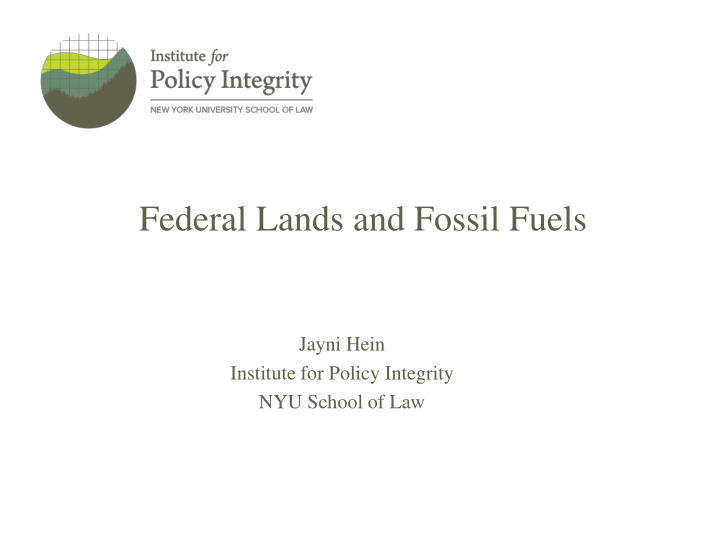



Federal Lands and Fossil Fuels Jayni Hein Institute for Policy Integrity NYU School of Law
Overview Federal Lands and Fossil Fuels: Maximizing Social Welfare in Federal • Energy Leasing , 42 HARV. ENVTL. L. REV. 1 (2018) Dept. of Interior’s broad statutory mandates should be reinterpreted • to account for economic and environmental values in more robust manner Fiscal reform can be used as a policy lever to help achieve climate • goals Royalty reform: carbon adder case studies • • Pros and cons of fiscal reform versus other policy mechanisms 2
Interior’s Fiscal Terms Minimum bids • – Oil and gas: $2/acre (1978) – Coal: $100/acre (1982) Rents • – Oil and gas: $1.50-2/acre – Coal: $3/acre Royalties • – Onshore oil, gas, and surface-mined coal: 12.5% (1920) – Offshore oil: 18.75% (deepwater); 12.5% (shallow water) 3
Interior’s Statutory Mandates • Mineral Leasing Act – Set fiscal terms as necessary for the “safeguarding of public welfare” • Federal Land Policy & Management Act – “Multiple use” and “sustained yield” mandate – Meet present and future needs of public – “ F air market value” requirement • Outer Continental Shelf Lands Act – Balance economic, environmental, and social values • Interior’s objective can/should be to maximize net public benefits by accounting for externality costs 4
How can Interior maximize social welfare? • Programmatic planning process – Long-term plans – Programmatic Environmental Impact Statements • Evaluate alternatives – Higher royalty rate scenarios (including carbon adders) – Declining production cap – No new leases • Ideally, compare the effects, including the relative emissions of energy substitutes, using a sophisticated, transparent model – Courts agree. 10th Cir: “perfect substitution assumption…[is] irrational (i.e., contrary to basic supply and demand principles).” 5
Social Cost of GHGs 2016 IWG Estimates (2017$ per metric ton) Social Cost of Carbon Social Cost of Methane Social Cost of Nitrous Dioxide Oxide Year Low (5% Central High High Low (5% Central High High Low (5% Central High High discount) (3% (2.5% Impact discount) (3% (2.5% Impact discount) (3% (2.5% Impact (95 th %) (95 th %) (95 th %) discount) discount) discount) discount) discount) discount) 2020 $14 $50 $74 $148 $648 $1440 $1920 $3839 $5639 $17,996 $26,393 $46,788 2025 $17 $55 $82 $166 $780 $1680 $2159 $4439 $6598 $20,395 $28,793 $52,787 2030 $19 $60 $88 $182 $912 $1920 $2399 $5039 $7558 $22,794 $32,392 $58,785 2035 $22 $66 $94 $202 $1080 $2159 $2759 $5879 $8878 $25,194 $34,791 $65,984 $25 $101 $220 $1200 $2399 $3119 $6598 $10,078 $27,593 $38,390 $71,982 2040 $72 2045 $28 $77 $107 $236 $1440 $2759 $3359 $7318 $11,397 $29,993 $40,790 $79,180 $31 $114 $254 $1560 $2999 $3719 $8038 $13,197 $32,392 $44,389 $86,379 2050 $83 6
Clean Power Plan vs. Royalty Rate Adders Final Clean Power Plan ( nat’l trading Coal Royalty Adders (Reeder & Stock case) (2016)) • Total national electricity emissions • Changes in 2030, relative to no CPP base case (CO 2 emissions - mmt) 32% lower than 2005 levels by 2030 • 20% SCC ($15.30/ton of coal) -54 • CO 2 emissions cut by 145 mmt by • 50% SCC ($38.30/ton -155 2020; 388 mmt by 2030 • 100% SCC ($76.70/ton) -260 • Changes in 2030, relative to CPP/mass- based case (CO 2 emissions - mmt) • 20% SCC -10 • 50% SCC -37 • 100% SCC -90 • Royalty adder generates revenues for affected states and federal coal community transition
Source: Reeder & Stock, Federal Coal Leasing Reform Options: Effects on CO2 Emissions and Energy Markets (2016) 8
State revenues, $ millions (2012 dollars) Effect of 20%, 50% policy scenarios on state coal royalty revenues (Reeder & Stock 2016) 9
Other Policy Scenarios • Upstream methane and transportation externalities (Hein & Howard, 2015) – $1/ton methane; $10/ton transp. externalities • Maximizing return to taxpayer (White House CEA, 2016) – $30/ton adder • No new fossil fuel leases or renewals (Erickson & Lazarus, 2018) 10
Takeaways • Interior has ample discretion to reimagine its federal leasing policies to increase social welfare • Fiscal reform can drive meaningful emission reductions, even after accounting for energy substitution • Addressing climate change through fiscal reform offers some revenue benefit to federal, state, and local governments • Can assist communities in transition away from fossil fuel dependence • Multiple avenues to addressing emissions – each with environmental, social, and economic tradeoffs – Not acting to address emissions is costly option 11
Recommend
More recommend